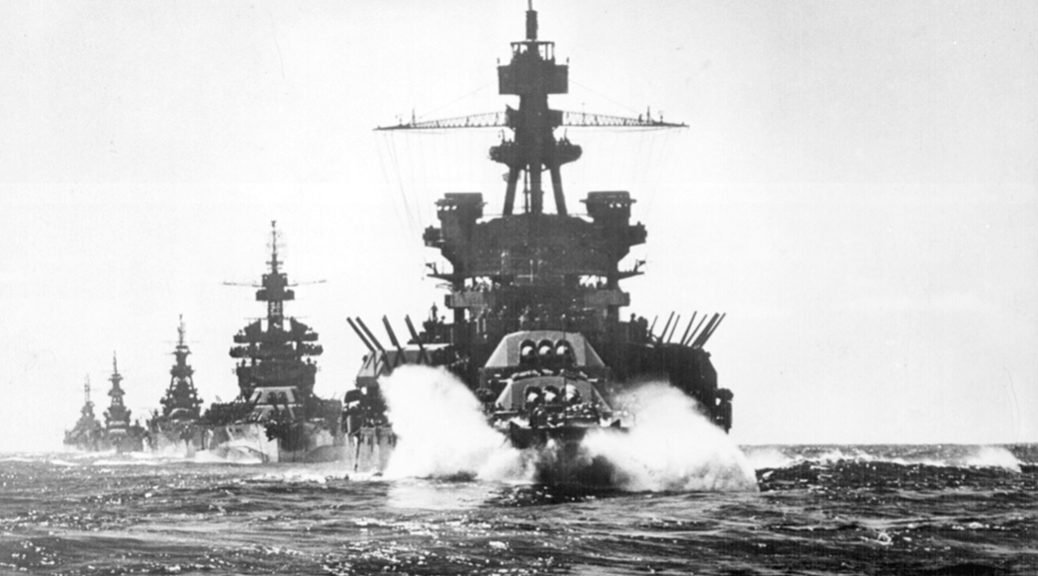In mid-January, 1944, the US Navy unleashed a powerful new offensive weapon against the Empire of Japan. The Pacific Theater of Operation shifted from defensive battles in the South Pacific to an organized, aggressive Plan of Attack against Japanese perimeter defenses all across the Central Pacific*. This new concept centered around utilizing fighter and bomber planes, unleashed from the decks of Fast Aircraft Carriers, to attack enemy strongholds and soften enemy defenses prior to landing assault forces.
To shift the role of the carrier planes from defense to aggressive offense, the aircraft carrier groups required significant protection from Capital Ships (battleships and cruisers) and perimeter (picket) screening from destroyers to ward off counter strikes by Japanese planes and/or submarines. A typical “Task Group” was formed in a large circle consisting of four aircraft carriers, circled by several battleships and as many as six cruisers. At least a dozen, but often many more destroyers formed the “outer ring.” The disposition of the group, as it traveled through Pacific waters, was several miles in circumference, and the Task Groups tended to travel ten or twelve miles apart from each other.
Typically, Task Force 58 was a collection of four self-sufficient Task Groups that prosecuted the war island-group by island-group, always advancing toward Japan. (Certain Operations and “Battle Line” groups morphed into either three or five Task Groups, but four was typical.) On any given day, the Task Force constituted just about one hundred warships.
(*Except the April 21, 1944 Hollandia Invasion [New Guinea])
TASK FORCE 58 OR TASK FORCE 38?
All the key characters were active Navy Commanders who were aboard the ships! Fleet Admiral Chester Nimitz and his planners (in Pearl Harbor) devised the TF58 or TF38 strategy – changing the designation of the Task Force (roughly) every six months. This accomplished many things, including confusing the enemy as to the strength of their opponents. This was a very tangible result of the designation change. Most important was that the commanders were relieved from battle, and brought back to headquarters to assist in planning the next six-months of Operations.
Timeline:
January 6, 1944: Task Force 58 formed (depart Pearl Harbor, HI). Starting in the early December 1943, new warships began arriving at Pearl Harbor from shipyards all over the US. They began practicing fleet maneuvers until January 19th, when the ships gathered en masse and headed for the Marshall Islands.
August 26, 1944: Task Force 58 > Task Force 38 (depart Eniwetok Anchorage, Marshall Islands). After Operations Flintlock and Catchpole (Marshall Islands Capture; Raids on Truk, Palau, and Marcus-Wake Islands), and Forager (Marianas), the ships anchored in Eniwetok, awaiting the next Operations.
January 26, 1945: Task Force 38 > Task Force 58 (depart Ulithi Anchorage). After the grueling Operation King II, Love III, Mike I (Philippine Campaigns), Operation Gratitude (SE French Indochina), the ships gathered in the anchorage at Ulithi, awaiting the next Operations.
May 28, 1945: Task Force 58 > Task Force 38 (depart Ulithi). After the ships withstood the Iwo Jima invasion, and were hammered by kamikazes throughout Okinawa Operation Iceberg (Okinawa), they anchored in Ulithi, awaiting the next Operations.
May 28, 1945 to September 2, 1945 (Surrender Day) The ships of Task Force 38 pound the Japanese Home Islands in a series of Raids that culminate in their Surrender (August 15, 1945) and the Signing of the Peace Treaty aboard the USS Missouri.
Note: many ships were assigned to Occupation Duty, staying in Japanese waters confiscating arms and destroying suicide vessels until early 1946.
